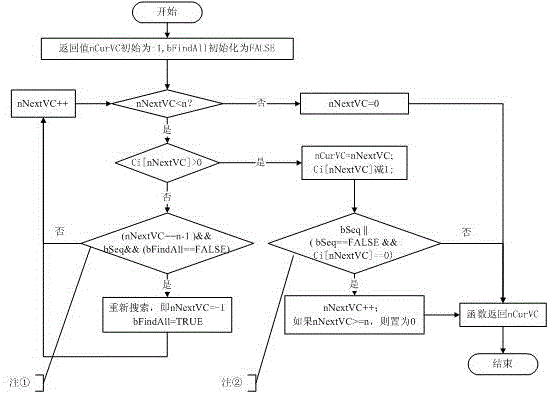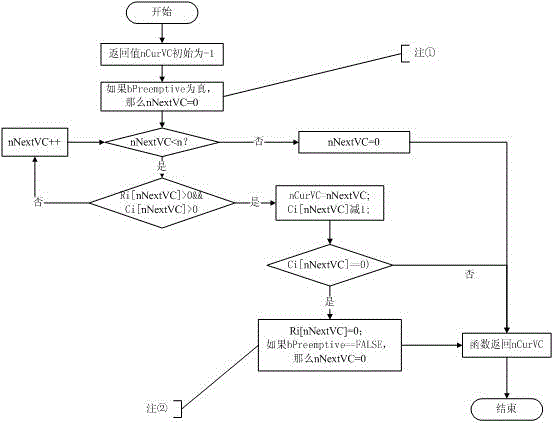Virtual channel general scheduling algorithm based on dynamic windows
A virtual channel and scheduling algorithm technology, applied in transmission monitoring, electrical components, transmission systems, etc., can solve the problem of different virtual channel scheduling algorithms, and achieve the effect of improving channel utilization.
- Summary
- Abstract
- Description
- Claims
- Application Information
AI Technical Summary
Problems solved by technology
Method used
Image
Examples
Embodiment approach 1
[0089] Implementation mode 1: full synchronous scheduling, including sequential synchronous scheduling and exclusive synchronous scheduling.
[0090] Step A. Configure the second row "Scheduling Strategy" in the "Scheduling Strategy Table", as shown in Table 9, if the strategy adopted by the synchronization scheduling is sequential, then fill in 1 for "Scheduling Strategy", otherwise fill in 0;
[0091] Step B, configure the "Window Scheduling Ratio Table", as shown in Table 10, where E=0, S=1, A=0, that is, only the synchronization window is reserved;
[0092] Step C, configure the "Synchronous Channel Schedule", as shown in Table 11, m is the number of channels, and the calculation method of "initial rotation times" (Ni) is as follows: the virtual channels VS1~VSm are calculated according to the transmission cycle T1~Tm from small to Large sorting, that is, T1≤T2≤...≤Tm, assuming that the telemetry frame period is T, obviously Ti should be an integer multiple of T. Calculat...
Embodiment approach 2
[0094] Implementation mode 2: full asynchronous scheduling, including preemptive asynchronous scheduling and preemptive asynchronous asynchronous scheduling.
[0095] Step A. Configure the third line "Asynchronous Scheduling" in the "Scheduling Policy Table", as shown in Table 9, if the policy adopted by the asynchronous scheduling is preemptive, then fill in 1 for "Scheduling Policy", otherwise fill in 0;
[0096] Step B, configure the "Window Scheduling Ratio Table", as shown in Table 10, where E=0, S=0, A=1, that is, only asynchronous windows are reserved;
[0097] Step C. Configure the "Asynchronous Channel Scheduling Table", as shown in Table 11, n is the number of channels, and the "initial transmission frame number" (Si) is calculated as follows: the virtual channels VA1~VAn are assigned according to the initial priority P1~Pn Sort from large to small, that is, P1≥P2≥...≥Pn, assuming that the telemetry frame period is T, and the transmission time occupied by the virtual...
Embodiment approach 3
[0099] Implementation Mode Three: Synchronous / Asynchronous Hybrid Scheduling.
[0100] Step A, configure the "Scheduling Policy Table", as shown in Table 9. The first line "window scheduling", if the strategy adopted by window scheduling is sequential, then fill in 1 for "scheduling strategy", otherwise fill in 0; the second line "synchronous scheduling", if the strategy adopted by synchronous scheduling is sequential, then " Fill in 1 for "scheduling strategy", otherwise fill in 0; line 3 "asynchronous scheduling", if the strategy adopted by asynchronous scheduling is preemptive, then fill in 1 for "scheduling strategy", otherwise fill in 0;
[0101] Step B, configure "Window Scheduling Ratio Table", as shown in Table 10, where E=0, S and A are set according to the ratio of synchronous / asynchronous scheduling;
[0102] Step C, configuring the "Synchronization Channel Schedule" according to Step C of Embodiment 1;
[0103] Step D, configure the "Asynchronous Channel Scheduli...
PUM
 Login to View More
Login to View More Abstract
Description
Claims
Application Information
 Login to View More
Login to View More - Generate Ideas
- Intellectual Property
- Life Sciences
- Materials
- Tech Scout
- Unparalleled Data Quality
- Higher Quality Content
- 60% Fewer Hallucinations
Browse by: Latest US Patents, China's latest patents, Technical Efficacy Thesaurus, Application Domain, Technology Topic, Popular Technical Reports.
© 2025 PatSnap. All rights reserved.Legal|Privacy policy|Modern Slavery Act Transparency Statement|Sitemap|About US| Contact US: help@patsnap.com



